Bigfoot’s Killer-N 1102 Wireless Networking vs. the World
by Jarred Walton on August 10, 2011 10:38 AM ESTCisco/Linksys E4200 Dual-Band Ideal Performance
Now we switch over to the Linksys E4200 router, a dual-band router capable of up to three spatial streams on 5GHz, or two streams on 2.4GHz. Since several of the wireless cards don’t support 5GHz radios, we test with both radios on the router. For the Bigfoot 1102, Intel 6230, and Intel 6300 we enable only the 5GHz radio on the router, while for the other three wireless cards (Atheros, Intel 1030, and Realtek) we use the 2.4GHz radio. This is also going to be the real comparison for the Intel Ultimate-N 6300, as it can finally flex its 450Mbps muscle (in theory) to provide higher throughput. Again, we’ll start with the ideal tests before moving to an obstructed location.
Interestingly, many of the 2.4GHz cards actually perform worse with the Linksys router. It doesn’t matter whether we disable the 5GHz radio or not; the Atheros refuses to connect at anything more than 144Mbps (and is frequently at 130Mbps). The Realtek also negotiates a 72Mbps stream instead of 144Mbps. On the other hand, the Bigfoot 1102, Intel 6230, and Intel 6300 all connect at 300Mbps when we disable the 5GHz radio, so the two spatial streams are in fact working, but if any of these drop to a 144Mbps signal (20MHz vs. 40MHz channel), they’ll generally stay there. That’s often a “works as designed” feature, and the crowded 2.4GHz spectrum means a lot of cards will see enough stuff out there that they won’t even try for 40MHz channels, but it’s still irritating.
With the 5GHz radio enabled, the Bigfoot and Intel 6230 both connect at 300Mbps on their 5GHz radios, and the Intel 6300 achieves a 450Mbps connection…sometimes. Even though it’s in the same room as the router, the Intel 6300 often cycles between 450Mbps, 405Mbps, 360Mbps, and even 270Mbps. We worked to get it to link up at a relatively steady 450Mbps, and eventually found a sweet spot with the laptop balanced on top of a box in the center of the room, but it still drops to lower rates on occasion. Also odd is that the Atheros and Bigfoot both appear to report the maximum theoretical connection rate and don’t ever show lower values, even though performance clearly drops off. That means the Bigfoot always shows 300Mbps on 5GHz, and either 300Mbps or 144Mbps (depending on whether the router is using a 40MHz channel) for 2.4GHz.
We mentioned earlier that Bigfoot had a different set of parameters for the Netperf testing, and this is the only page where we’re using their results. As you’ll see below, TCP throughput actually improves on all of the cards compared to running the default test, but the UDP throughput is in the toilet for everyone other than Bigfoot. Intel in particular doesn’t do well on UDP with the settings recommended by Bigfoot, with all three tested Intel cards apparently capped at 3-4Mbps. This is very likely a driver optimization problem, and Bigfoot suggested that Intel has focused on 1000 byte packets for UDP performance, which is why performance drops. More on this in a second.

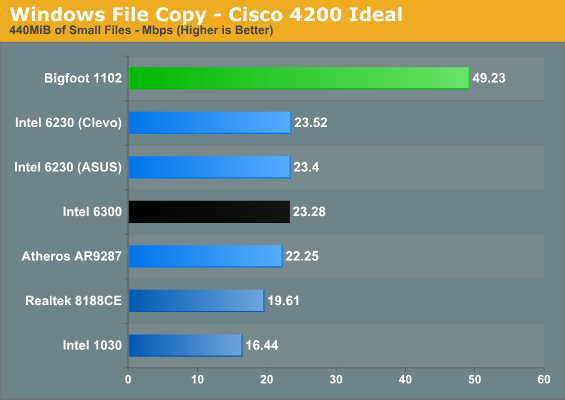
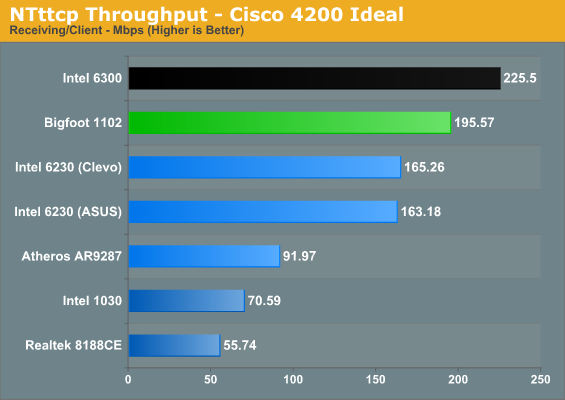
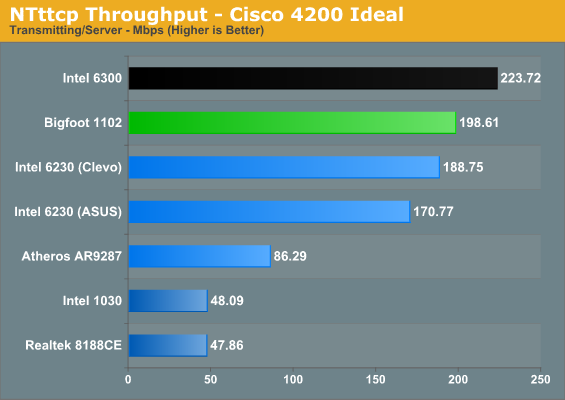
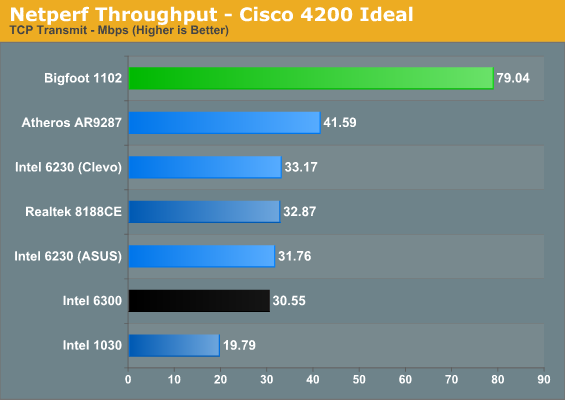
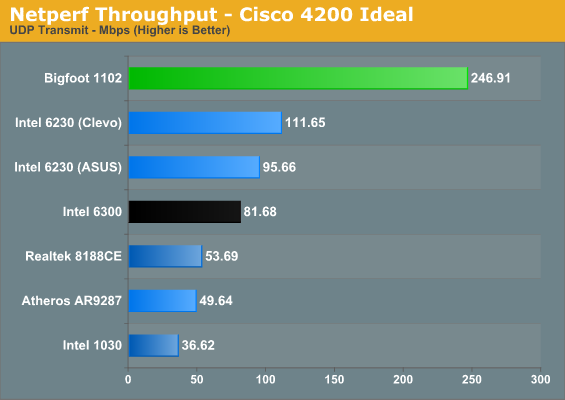
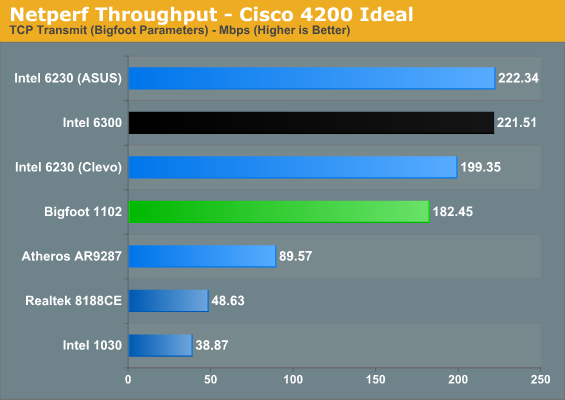
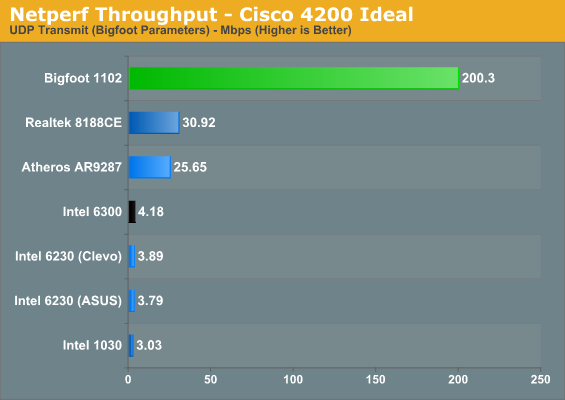
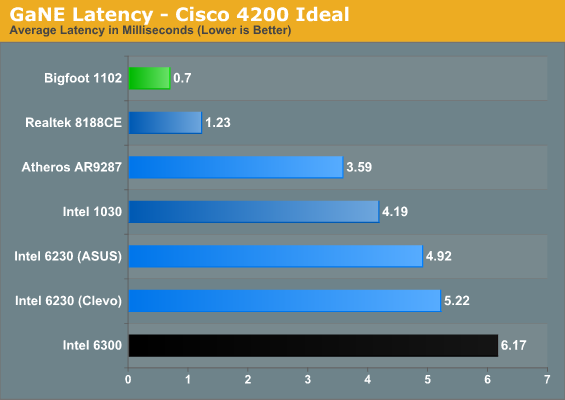

In our best-case results using the Linksys E4200, most of the performance patterns we saw with the Netgear router remain in place. The Bigfoot continues to provide stellar latency results—even better than with the 2.4GHz Netgear router—and this is reflected in the excellent small file copy result. However, now that we’re using a 5GHz radio, both Intel 6230 laptops perform much better, and the Intel 6300 can finally claim a few victories.
Where Intel’s 6300 shines is in raw throughput. The three spatial streams allow it to reach the highest raw bandwidth in NTttcp, coming in over 10% faster than the Bigfoot 1102, which in turn is about 10% faster than the Intel 6230. The single large file transfer also does well on the 6300, and the K53E 6230 manages to tie the Bigfoot—though the same laptop chassis with a 6230 still falls behind. Given the 2.4GHz radios and lower connection rates on the other cards, it’s no surprise that they fail to match the Bigfoot and Intel 6230/6300 results in tests where throughput matters.
Despite the great showing in the NTttcp tests, the Intel 6300 falters in the Netperf results and Bigfoot gets another victory. Using the default test setup, the Bigfoot 1102 actually delivered more than twice the throughput of the nearest competitor in Netperf. Switch to the Bigfoot parameters and the Intel 6230 and 6300 lead in the TCP test, but as noted above all of the Intel cards have a serious problem with the UDP testing. Of course, even if Bigfoot is correct and their UDP parameters reflect usage scenarios with larger packet sizes, we have to ask: does it really matter? UDP generally isn’t useful for transferring large amounts of data, and even 3Mbps is more bandwidth than most applications will ever need. It could be an issue down the road, but the Netperf UDP results (note that the results are for transmitting, not receiving) don’t necessarily come into play in the real world.
Do we still have a winner? It’s not quite as impressive as the results with the Netgear router, but overall the Bigfoot 1102 delivers the best experience with the Linksys router. Raw throughput isn’t often the bottleneck, particularly when gaming, and the consistency of connection, low latency, and extra utilities that Bigfoot offers certainly come in handy. If you had to pay $50 to $100+ more for the Bigfoot Killer Wireless-N wireless cards, like you did with their Ethernet Killer Networking cards, it wouldn’t be so easy to pick a winner. However, right now every laptop purchased from Mythlogic comes with the Bigfoot Killer Wireless-N 1102. If that’s not a ringing endorsement, I don’t know what is: Mythlogic is happy enough with the results they’ve seen on the 1102 that they’re no longer even bothering to offer Intel alternatives. If the 1102 is not enough, Mythlogic also offers Bigfoot’s Killer Wireless-N 1103 that supports 3x3:3 MIMO for another $15. We haven’t had a chance to test the 1103, but given the smackdown the 1102 delivers to the 2x2:2 competition, it’s pretty safe to assume the 1103 will reign supreme. (If we can get one for testing, we’ll be sure to put it through the same tests as we’ve done here.)










52 Comments
View All Comments
neothe0ne - Sunday, August 14, 2011 - link
"And Dell, Asus, Acer, and Sony all do the same thing."Are you sure about that? I was under the impression HP and Lenovo were alone in the industry with the WLAN whitelist. And anyway, Dell does offer the Intel Centrino 6230 on the XPS 15 now, unlike HP's dv6 which is stuck in budget-tier Intel WiFi Link 1000 land.
cjl - Tuesday, August 16, 2011 - link
Dell, at least in their Alienware products, definitely does not whitelist. After reading this article, I got one of the Killer 1102 cards for my M11xR2 (which comes with a rather terrible card by default, and there were no upgrade options offered), and it works just fine. I popped it in, installed the drivers, and everything has been working great since.Musafir_86 - Thursday, August 11, 2011 - link
Hello,-Thanks for the article, but did you tested those adapters with or without any security/encryption/password protection scheme? I mean WEP or WPA/WPA2 - I think encryption put some overhead in the throughput.
Thanks.
JarredWalton - Thursday, August 11, 2011 - link
All testing was done with WPA2 AES. Most modern cards do fine with that, though a few years back it was sometimes slower IIRC.Musafir_86 - Thursday, August 11, 2011 - link
-Okay, thanks for the clarification. :)Yummer72 - Thursday, August 11, 2011 - link
Thanks for the informative review.I wonder if Bigfoot will continue to have an advantage if the "WLAN Optimizer" program was used with the other WiFi cards?
http://www.martin-majowski.de/wlanoptimizer/
I have personally seen significantly improved performance and the elimination of "lag spikes" (QuakeLive) with this software tweak.
Any comments?
JarredWalton - Thursday, August 11, 2011 - link
I'll give that a try; it could very well remove the spikes, leaving the primary advantage as the lower base latency.bhima - Thursday, August 11, 2011 - link
You should review that 95% color gamut matte screen in that Mythlogic ;)loopingz - Thursday, August 11, 2011 - link
First of all thanks for highlighting that I can change my wifi adaptator on my laptop. Mine is always frozing during transfert in windows (linux is fine).Second thanks for helping me choosing the good one.
I hesitate now between intel 6300 for range, correct performance and price, and the 110 2/3 for pure performance.
May be best of two worlds intel 6300 in the eeepc that travel a lot and bigfoot in the main home laptop.
Can I recycle a my old wifi card or a new one using an antenna and puting it in my desktop computer?
I will give try to Wlanoptimizer too because watching movie from the raid5 nas still not perfect (router linksys e3k).
Thanks for the good job.
name99 - Thursday, August 11, 2011 - link
"Wireless networking also tends to need more overhead for error checking and interference losses, and there’s a question of whether the streams are linearly independent enough to get higher throughput, orientation, directionality of signal, etc. Even though you might connect at 450Mbps or 300Mbps, you’ll never actually reach anywhere near that level of throughput. In our testing, the highest throughput we ever saw was around 75% utilization of the available bandwidth, and that was on a 300Mbps connection."This is not a useful description of the situation. The nominal speed of a connection (ie the MCS index) already includes error correction overhead --- that's why you see a range of bit-rates, with the same parameters (modulation, number of streams, bandwidth) --- these different bit-rates correspond to different levels of error correction, from the strongest (1/2 coding rate) to the weakest (5/6).
It is also unlikely that corrupt packets and the retransmission (what you are calling "interference losses", though in your environment noise is likely more relevant than interference) are substantial --- both ends aggressively modify the MCS index to get the best throughput, and try to keep the number of corrupt packets low.
The real issue is the MAC --- the negotiations over who next gets airtime. This used to be a big deal with wired ethernet as well, of course, but it went away with switches around the time we all moved to 100TX. The basic 802.11n MAC does not rely on any real co-ordination, just on timing windows and retries, and it wastes a phenomenal amount of time. 802.11e improves the situation somewhat (I expect all the systems that get 75% efficiency are using 802.11e, otherwise they'd see around 50% efficiency), but it's still not perfect.
What one really wants is a central arbiter (like in a cell system) that hands out time slots, with very specific rules about who can talk when. For reasons I don't understand, 802.11 has been very resistant to adding such a MAC protocol (802.11e has elements of this, but does not go full-hog), but I would not be surprised if we finally see such as part of the 802.11n successor --- it's just such an obvious place to pick up some improvement. The real problem is that to do it right you have to give up backward compatibility, and no-one wants to do that. At least if we'd had it in 802.11n, then we'd be part way to a better world (people could switch it on once all their g equipment died, eg at home).